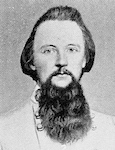 Open main menu
Open main menu
 Open main menu
Open main menu

G.B. Anderson
(1831 - 1862)
Home State: North Carolina
Education: U of North Carolina, USMA, Class of 1852;Class Rank: 10th
Command Billet: Brigade Commander
Branch of Service: Infantry
Unit: Anderson's (NC) Brigade
Before Sharpsburg
He was a student at the University of North Carolina (1847-48) before receiving an appointment to the US Military Academy at West Point. On graduation he was appointed brevet 2nd Lieutenant, 2nd US Dragoons, to date from 1 July 1852. He was commissioned 2nd Lieutenant on 21 March 1854 and First Lieutenant 13 December 1855 and served in the West: to California on the Pacific Railroad expedition, then at posts in Texas and Kansas. He was regimental Adjutant from 27 May to 8 September 1857 (at Ft. Leavenworth, KS) and from 8 August 1858 to 24 June 1859 (Ft. Crittenden, UT). His last frontier station was at Ft. Kearney, NE and then he was on recruiting duty. He resigned his commission on 25 April 1861 to go South, perhaps the first officer from North Carolina to do so.
He was commissioned Colonel of the 4th North Carolina Infantry on 16 May 1861 and saw action leading them at Williamsburg on 5 May 1862. He was appointed Brigadier General on 16 June and commanded his (formerly Featherston's) Brigade in D.H. Hill's Division at the Seven Days, Malvern Hill (where he was wounded), and at South Mountain.
On the Campaign
He commanded Anderson's (NC) Brigade in D.H. Hill's Division in Maryland and was wounded by gunshot to the foot near his ankle in the fighting at the Sunken Road at Sharpsburg on 17 September 1862.
The rest of the War
He was taken across the Potomac River and treated at the Boteler home in Shepherdstown, VA, until Friday the 19th, but to avoid capture he was then carried by wagon to Staunton, VA and on by rail to Raleigh, NC and the home of his brother William E. Anderson. He traveled with another brother, Lieutenant R. Walker Anderson, his aide de camp, who was also wounded at Sharpsburg. About two weeks after arriving in Raleigh George's leg was amputated due to infection, and he died of his wound on 16 October 1862. He was 31 years old.
He was one of the 6 General Officers killed or mortally wounded at Sharpsburg, and was honored about 1897 by a mortuary cannon on the battlefield.
References & notes
His service from Heitman,1 the Roster,2 and Clark,3 source of his picture. US Army postings from Cullum.4 Anderson's Cullum number is 1545. Further details from a piece about his wounding and care in the Wilmington Journal of 31 May 1867 online from the Library of Congress. Thanks to Laura Elliott for providing that clipping. Personal information from family genealogists. His gravesite is on Findagrave. He is often seen as George Burgwyn Anderson.
Son of Frances Eliza Bush Burgwin and William Edward Anderson, he married Mildred Butler Ewing (1838-1899) in November 1859. Their first child Ewing's first birthday was the day before his father was wounded at Sharpsburg. Their second child, George Burgwin was born two days after his father died. The infant boy Ewing died just two weeks later.
More on the Web
His papers are in the collection of the North Carolina State Archives, Raleigh [finding aid].
Birth
04/12/1831; Hillsboro, NC
Death
10/16/1862; Raleigh, NC; burial in Oakwood Cemetery, Raleigh, NC
1 Heitman, Francis Bernard, Historical Register and Dictionary of the United States Army 1789-1903, 2 volumes, Washington DC: US Government Printing Office, 1903, Vol. 1, pg. 163 [AotW citation 21216]
2 Manarin, Louis H., and Weymouth Tyree Jordan, Matthew M Brown, Michael W Coffey, North Carolina Troops, 1861-1865 : A Roster, 20 Volumes +, Raleigh: North Carolina State Department of Archives and History, 1966- [AotW citation 21217]
3 Clark, Walter, editor, Histories of the Several Regiments and Battalions from North Carolina in the Great War, 1861-1865, 5 vols., Raleigh and Goldsboro (NC): E. M. Uzzell, Nash Brothers, printers, 1901, Vol. 1, opp. pg. 229 [AotW citation 21218]
4 Cullum, George Washington, Biographical Register of the Officers and Graduates of the US Military Academy, 2nd Edition, 3 vols., New York: D. Van Nostrand, 1868-79, Vol. 2, pg. 480 [AotW citation 21220]